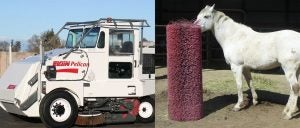Since the development of agriculture 12,000 years ago, farmers and ranchers have continued to improve their operations by being resourceful and innovative.
For example, in the 1930s, when “repair, reuse, make do, and don’t throw anything away” became a motto during the Great Depression, many farm families repurposed what they had — even in their households. It was common to see children wearing clothes made from recycled livestock feed sacks. This trend became so popular that some feed company owners began putting patterns on the sacks.
Fast forward to today, and this same “reuse” mentality is still anchored in the lifestyles of farmers and ranchers. They commonly use old wooden railroad ties for fence posts; they upcycle 55 gallon drums to make hydroponic systems; and they repurpose fire hoses to cool off livestock — saving cattle from heat exhaustion.
Repurposing materials is now so popular that companies housing and selling recycled materials are almost commonplace. One such company, repurposedMaterials, owned by Damon Carson, gives materials a second life.
“It’s all about keeping a byproduct or waste stream out of the landfill,” said Carson, who was inspired to start his business in 2010 after working for years in the waste industry.
“It always surprised me how much good stuff was being thrown away in America,” he said.
Finding the treasure in others’ trash
Today, Carson has warehouses in Arizona, Colorado, Texas, Iowa, and South Carolina — all filled with salvaged or surplus materials ready for new life.
“Anything that is obsolete to its primary industry is of interest to us,” said Carson. “I always say I have the most interesting inbox. I never know what I’m waking up to.”
For Carson, choosing what to resell is something he’s perfected over time due to supply and demand patterns. Although he caters to industries other than ag (like selling old ski lifts to contractors to repurpose as railings) the majority of his business comes from farmers and ranchers.
Kody Lostroh, owner of Shield of Faith Cattle Company in Colorado, purchased old mining conveyor belts from repurposedMaterials to use as windbreaks for cattle on his ranch.
“Instead of laying the belting out horizontally, I found it easier to cut into pieces and install it vertically,” said Lostroh, who said the belting will be beneficial during cold and snowy Colorado winters to keep the wind at bay.
“And unless a bull’s horns gets in there and rips it somehow, the belts — which are about three-eighths inches thick — should last a lifetime.”

Lostroh also uses old mining truck tires (cut in half) for water troughs in his fields and uses street-sweeper brushes for cattle rubs.
“I like to spray fly spray on the brushes so when the cattle rub against it, they’ll be covered and it’ll help keep the flies away,” Lostroh said.
On the ranch, Lostroh built all of his pens using second-hand pipe and cable.
“The biggest benefit to repurposing materials other than keeping stuff out of landfills is the cost,” added Lostroh. “It’s an economical way of doing things and there are a lot of really durable products that were made for other industries that are no longer suitable for that, but for ranchers and farmers they are still quality and durable materials that could last a very long time.”
Also in Colorado, farmer Ted Carlson purchased a few old billboard tarps from repurposedMaterials to stretch over trusses made from old highway signposts. He sewed them together with a seed sack sewer to create a shelter for his grass seed farming equipment.
Building on the benefits
Logistically, sourcing items destined for the landfill for farmers, ranchers, and other industry owners to purchase is often a win-win.
“I can source materials from companies and often save them the cost of disposal fees,” Carson said. “In turn, I’m able to store those materials and resell them at a reasonable cost to industries in need.”
“I look for items that are generic, versatile and adaptable,” added Carson.

On the repurposedMaterials website, Carson lists a variety of reusable materials: From concrete to steel and metal, there’s always something ready to be repurposed. There’s even a category called “weirdStuff,” where you’ll find unique and odd items like pallets of hamburger bun pans, blast resistant trash cans, and a 6-by-6-foot diesel chassis.
As ranchers and farmers continue to take steps to protect the land, water, and air around them, the value of recycling is evident. You could say the ag community still embodies the “repair, reuse, make do, and don’t throw anything away” mentality.
Suzanne Downing is an outdoor writer and photographer in Montana with an environmental science journalism background. Her work can be found in Outdoors Unlimited, Bugle Magazine, Missoulian, Byline Magazine, Communique, MTPR online, UM Native News, National Wildlife Federation campaigns and more.



